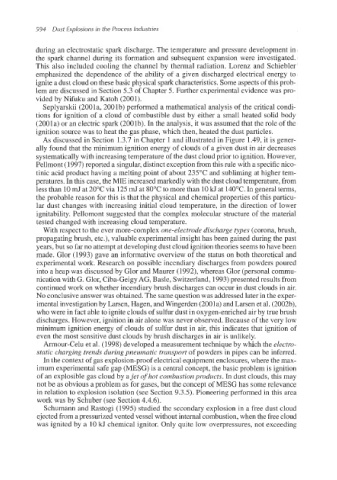Page 627 - Dust Explosions in the Process Industries
P. 627
594 Dust Explosions in the Process Industries
during an electrostatic spark discharge. The temperature and pressure development in
the spark channel during its formation and subsequent expansion were investigated.
This also included cooling the channel by thermal radiation. Lorenz and Schiebler
emphasized the dependence of the ability of a given discharged electrical energy to
ignite a dust cloud on these basic physical spark characteristics.Some aspects of this prob-
lem are discussed in Section 5.3 of Chapter 5. Further experimental evidence was pro-
vided by Nifuku and Katoh (2001).
Seplyarskii (2001a, 2001b) performed a mathematical analysis of the critical condi-
tions for ignition of a cloud of combustible dust by either a small heated solid body
(2001a) or an electric spark (2001b). In the analysis, it was assumed that the role of the
ignition source was to heat the gas phase, which then, heated the dust particles.
As discussed in Section 1.3.7 in Chapter 1 and illustrated in Figure 1.49, it is gener-
ally found that the minimum ignition energy of clouds of a given dust in air decreases
systematicallywith increasing temperature of the dust cloud prior to ignition. However,
Pellmont (1997) reported a singular,distinct exception from this rule with a specificnico-
tinic acid product having a melting point of about 235°C and subliming at higher tem-
peratures. In this case, the ME increased markedly with the dust cloud temperature, from
less than 10mJ at 20°C via 125mJat 80°C to more than 10kJat 140°C.In general terms,
the probable reason for this is that the physical and chemical properties of this particu-
lar dust changes with increasing initial cloud temperature, in the direction of lower
ignitability. Pellomont suggested that the complex molecular structure of the material
tested changed with increasing cloud temperature.
With respect to the ever more-complex one-electrode discharge types (corona, brush,
propagating brush, etc.), valuable experimental insight has been gained during the past
years, but so far no attempt at developing dust cloud ignition theories seems to have been
made. Glor (1993) gave an informative overview of the status on both theoretical and
experimental work. Research on possible incendiary discharges from powders poured
into a heap was discussed by Glor and Maurer (1992), whereas Glor (personal commu-
nication with G. Glor, Ciba-GeigyAG, Basle, Switzerland, 1993)presented results from
continued work on whether incendiary brush discharges can occur in dust clouds in air.
No conclusiveanswer was obtained. The same question was addressed later in the exper-
imental investigationby Larsen, Hagen, and Wingerden (2001a) and Larsen et al. (2002b),
who were in fact able to ignite clouds of sulfur dust in oxygen-enrichedair by true brush
discharges. However, ignition in air alone was never observed. Because of the very low
minimum ignition energy of clouds of sulfur dust in air, this indicates that ignition of
even the most sensitive dust clouds by brush discharges in air is unlikely.
Armour-Celu et al. (1998) developed a measurement technique by which the electro-
static charging trends during pneumatic transport of powders in pipes can be inferred.
In the context of gas explosion-proofelectrical equipmentenclosures,where the max-
imum experimental safe gap (MESG) is a central concept, the basic problem is ignition
of an explosible gas cloud by ajet of hot combustion products. In dust clouds, this may
not be as obvious a problem as for gases, but the concept of MESG has some relevance
in relation to explosion isolation (see Section 9.3.5). Pioneering performed in this area
work was by Schuber (see Section 4.4.6).
Schumann and Rastogi (1995) studied the secondary explosion in a free dust cloud
ejected from a pressurizedvented vessel without internal combustion,when the free cloud
was ignited by a 10 kJ chemical ignitor. Only quite low overpressures, not exceeding

